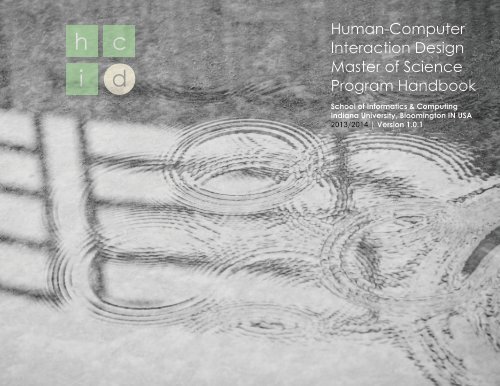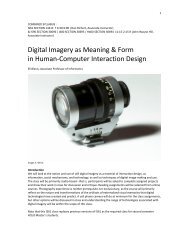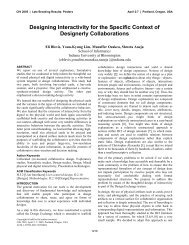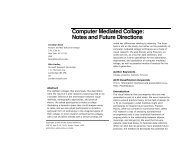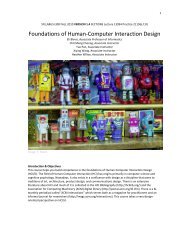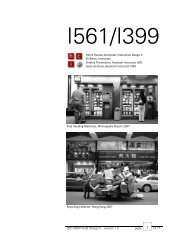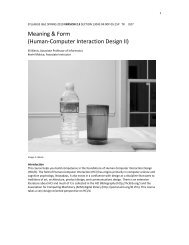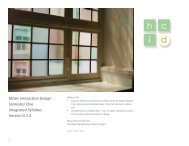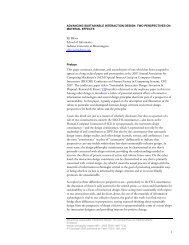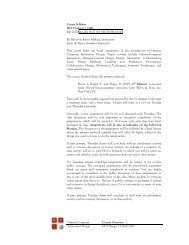Human-Computer Interaction Design Master of Science Program ...
Human-Computer Interaction Design Master of Science Program ...
Human-Computer Interaction Design Master of Science Program ...
You also want an ePaper? Increase the reach of your titles
YUMPU automatically turns print PDFs into web optimized ePapers that Google loves.
h c<br />
i d<br />
<strong>Human</strong>-<strong>Computer</strong><br />
<strong>Interaction</strong> <strong>Design</strong><br />
<strong>Master</strong> <strong>of</strong> <strong>Science</strong><br />
<strong>Program</strong> Handbook<br />
School <strong>of</strong> Informatics & Computing<br />
Indiana University, Bloomington IN USA<br />
2013/2014 | Version 1.0.1<br />
1
2 3
Contents<br />
1. Introduction<br />
2. HCI/d MS <strong>Program</strong> Structure<br />
3. Course Descriptions<br />
4. For Reference<br />
Kindly note that this handbook has been revised very<br />
extensively, this year—with so many changes, it should be<br />
considered as somewhat <strong>of</strong> a draft copy. Please allow for<br />
changes and additions to follow. Kindly direct questions<br />
about this document to Eli Blevis—eblevis@indiana.edu<br />
Unless otherwise indicated, images in this handbook are by<br />
Eli Blevis.<br />
1. Introduction<br />
This handbook details the <strong>Master</strong> <strong>of</strong> <strong>Science</strong> (MS)<br />
program in <strong>Human</strong>-<strong>Computer</strong> <strong>Interaction</strong> <strong>Design</strong><br />
(HCI/d) at the School <strong>of</strong> Informatics & Computing,<br />
Indiana University, Bloomington, Indiana USA.<br />
The Core HCI/d Faculty are:<br />
Jeff Bardzell<br />
Associate Pr<strong>of</strong>essor <strong>of</strong> Informatics<br />
Shaowen Bardzell<br />
Associate Pr<strong>of</strong>essor <strong>of</strong> Informatics<br />
Eli Blevis<br />
Associate Pr<strong>of</strong>essor <strong>of</strong> Informatics,<br />
Director <strong>of</strong> the HCI/d <strong>Program</strong><br />
Marty Siegel<br />
Pr<strong>of</strong>essor <strong>of</strong> Informatics,<br />
Director <strong>of</strong> Graduate <strong>Program</strong>s for Informatics<br />
Erik Stolterman<br />
Pr<strong>of</strong>essor <strong>of</strong> Informatics,<br />
Division Chair for Informatics<br />
Norman Su<br />
Assistant Pr<strong>of</strong>essor <strong>of</strong> Informatics<br />
The Staff associated with this program are:<br />
Linda Hostetter, Graduate Recorder<br />
Cheryl Engel, Admissions Assistant<br />
Kate Caldwell, Director <strong>of</strong> Career Services<br />
Kindly refer to www.soic.indiana.edu for contact and<br />
other details <strong>of</strong> these faculty and staff.<br />
The Director <strong>of</strong> the HCI/d program—Pr<strong>of</strong>. Eli Blevis—<br />
has the overall responsibility for the program, courses,<br />
and everything else that relates to the program. You<br />
may write to him about the program and once you<br />
are enrolled, you may contact him as well with any<br />
personal issues, concerns, or ideas you may have<br />
affecting your studies or the program or your wellbeing<br />
in general.<br />
The Graduate Director <strong>of</strong> the Informatics MS and<br />
PhD program—Pr<strong>of</strong>. Marty Siegel—is involved in more<br />
overall issues <strong>of</strong> being a graduate student in our<br />
school. You may also contact him with any issues or<br />
concerns, or just to chat. Marty is very friendly and<br />
approachable, with a great reputation for helping<br />
students.<br />
The collective goal <strong>of</strong> the core HCI/d faculty is to<br />
help you succeed in our program as an individual,<br />
while also ensuring that high standards are met as<br />
a collective investment in reputation by all faculty,<br />
students, and alumni who are connected to our program.<br />
Our goal is to be the best design-oriented HCI<br />
program in the world, and each <strong>of</strong> us participates in<br />
this vision.<br />
2. HCI/d MS <strong>Program</strong> Structure<br />
Schedule <strong>of</strong> Classes<br />
The <strong>Master</strong> <strong>of</strong> <strong>Science</strong> Degree <strong>Program</strong> in HCI/d<br />
consists <strong>of</strong> 36 credit hours <strong>of</strong> studies, normally taken<br />
over two consecutive years, evenly distributed as 3<br />
classes or 9 credit hours per semester.<br />
The schedules on the following pages show the<br />
classes you will take. There is some choice available<br />
in the second year <strong>of</strong> study in the form <strong>of</strong> electives.<br />
Since this is a two year program, the schedule shows<br />
classes in whole or in part for several different cohorts,<br />
for example:<br />
The Class <strong>of</strong> 2014<br />
Year 1 Fall 2013<br />
Year 1 Spring 2014<br />
Year 2 Fall 2013<br />
Year 2 Spring 2014<br />
The Class <strong>of</strong> 2015<br />
Year 1 Fall 2014<br />
Year 1 Spring 2015<br />
Year 2 Fall 2014<br />
Year 2 Spring 2015<br />
...<br />
and so forth<br />
Kindly read these schedules keeping your respective<br />
cohort in mind.<br />
4 5
How to Apply<br />
We are accepting applications for Fall 2014.<br />
Fall 2014 Priority Deadlines for<br />
Admission and Financial Aid:<br />
• International students: December 1, 2013<br />
• Domestic students: January 15, 2014<br />
For information about our graduate programs, go to<br />
http://www.soic.indiana.edu/graduate/index.shtml<br />
For information about how to apply to Indiana Uni-<br />
versity’s School <strong>of</strong> Informatics and Computing, go to<br />
http://www.soic.indiana.edu/prospective/grad-admit/apply/index.shtml.<br />
Special Instructions for HCI/d MS<br />
Students Application Portfolios<br />
HCI/d <strong>Program</strong> [Optional] Portfolio<br />
Purpose:<br />
A portfolio <strong>of</strong> your prior work will greatly help distinguish<br />
your application for the HCI/d program.<br />
Portfolios do not necessarily need to include only HCI<br />
or design work samples--they may include any sort<br />
<strong>of</strong> samples <strong>of</strong> your prior work as described below.<br />
We accept many students from a wide variety <strong>of</strong><br />
disciplines and backgrounds based on the quality<br />
<strong>of</strong> prior work, rather than the specific focus or area.<br />
Many excellent students begin the program without<br />
a background in HCI or design, and many excellent<br />
students do have prior HCI or design experience. A<br />
portfolio is optional, but highly recommended.<br />
Themes:<br />
The primary reason we accept students from a variety<br />
<strong>of</strong> different backgrounds is that our program is organized<br />
into three career-path themes, as described<br />
in the handbook, namely (i) interaction design, (ii)<br />
design strategies, and (iii) research, scholarship, &<br />
creative activity. Different backgrounds predict success<br />
in one area or another <strong>of</strong> these three careerpath<br />
themes. It is perfectly fine if you are not sure<br />
which <strong>of</strong> these three themes corresponds to your<br />
career goals before you start the program--however,<br />
the types <strong>of</strong> things you include in your portfolio may<br />
indicate a trajectory in one <strong>of</strong> these three themes or<br />
another, and we do hope to achieve a balanced<br />
distribution <strong>of</strong> accepted students among the three<br />
themes.<br />
Format:<br />
A single PDF file is the only acceptable format for<br />
your portfolio. If your PDF is larger than 2 MB, you<br />
must provide a link from which the portfolio can be<br />
downloaded. If your PDF file is smaller than 2 MB,<br />
you may send it as an email attachment. No other<br />
format aside from PDF is acceptable. Only one PDF<br />
file may be submitted. You may choose portrait or<br />
landscape mode. The paper size must be 8.5 inches<br />
x 11.0 inches. Your portfolio will not be considered if it<br />
does not meet these criteria.<br />
The first page <strong>of</strong> the PDF must include only your<br />
name and the following text: “I certify that the work<br />
included in this portfolio is my own original work. Work<br />
included which was conducted as part <strong>of</strong> a team<br />
or other group is indicated and attributed as such-<br />
-the other team members are named and a true<br />
description <strong>of</strong> my role in the project is included.” You<br />
must also include your signature on this title page<br />
indicating your certification <strong>of</strong> originality and proper<br />
attribution. In the event that any work you provide<br />
in your portfolio is improperly represented in terms<br />
<strong>of</strong> authorship, your application will be dismissed<br />
without review. We do apologize for including this<br />
requirement, and please do understand that it is a<br />
necessary requirement to secure the integrity <strong>of</strong> our<br />
community because <strong>of</strong> only a very few cases.<br />
Types <strong>of</strong> work to submit:<br />
You may include images and descriptions <strong>of</strong> any<br />
prior work, including and not limited to:<br />
• web site designs<br />
• interaction designs<br />
• any form <strong>of</strong> design work<br />
• published papers or essays<br />
• writing samples, including creative writing,<br />
research papers, and/or technical/pr<strong>of</strong>essional<br />
pieces<br />
• pr<strong>of</strong>essional work <strong>of</strong> any sort<br />
• design competition entries<br />
• photography<br />
• curricular materials you have developed<br />
• prototypes<br />
• samples <strong>of</strong> program code or other forms <strong>of</strong> engineering<br />
experience<br />
• ethnographic work<br />
• strategic design plans or other evidence <strong>of</strong> entrepreneurial<br />
experience<br />
To be very clear, the list above is not exhaustive and<br />
only illustrates the kinds <strong>of</strong> things you may wish to<br />
include. Do not worry if you do not have a lot <strong>of</strong> prior<br />
work or every kind <strong>of</strong> prior work to show--not every<br />
applicant is expected to have every type <strong>of</strong> experience.<br />
Focus on quality, rather than quantity. Combine<br />
the images and descriptions or your work and<br />
entire papers you wish to include into a single PDF<br />
file. A link to a website will not be considered, owing<br />
to the large number <strong>of</strong> applicants we receive--put<br />
your best work into a PDF portfolio format instead.<br />
Page limit:<br />
A good portfolio should usually be no more than 10<br />
pages; however, in the case that you are including<br />
published papers, it may understandably be longer-<br />
-thus, there is no hard and fast page limit. If your PDF<br />
file is longer than 10 pages, you must include a table<br />
<strong>of</strong> contents as the second page, and you may do so<br />
even if your PDF files is shorter.<br />
Important note:<br />
Please consider completing your portfolio carefully,<br />
before submitting. You may submit your portfolio only<br />
once. Please do not ask nor attempt to send revised<br />
portfolios--such requests will be rejected without response,<br />
due to the large number <strong>of</strong> such requests we<br />
would otherwise receive.<br />
6 7
Class Schedule: 2013/2014 (projected, subject to change)<br />
Year 2 Fall 2013 CLASS OF 2014 Year 2 Spring 2014 CLASS OF 2014 Year 1 Fall 2013 - CLASS OF 2015 Year 1 Spring 2014 CLASS OF 2015<br />
Required:<br />
I590 Prototyping<br />
Shaowen Bardzell<br />
Recommended Electives (Select 2):<br />
FINA S552 Graphics & Diagramiming<br />
TBD<br />
I604 <strong>Design</strong> Theory<br />
Erik Stolterman<br />
I590 Rapid <strong>Design</strong> for Slow Change<br />
Marty Siegel<br />
Required:<br />
I694 Capstone (6 Credits)<br />
Eli Blevis<br />
Recommended Electives (Select 1):<br />
I561 Meaning & Form in HCI/d (M+F)<br />
Eli Blevis (was elective Spring 2013)<br />
I590 <strong>Interaction</strong> Culture<br />
Jeff Bardzell<br />
I528 Participatory <strong>Design</strong><br />
Shaowen Bardzell & David Hakken<br />
I590 Specialty TBA<br />
Norman Su<br />
Undergraduate HCI/d Classes, including classes cross-listed with graduate<br />
classes:<br />
Fall 2013<br />
I300 Introduction to HCI/d Travis Brown<br />
I310 Multimedia Arts and Technology TBD<br />
Spring 2014<br />
I300 Introduction to HCI/d Marty Siegel<br />
I310 Multimedia Arts and Technology TBD<br />
Required:<br />
I541 <strong>Interaction</strong> <strong>Design</strong> Practice (IDP)<br />
Marty Siegel (6 Credits)<br />
I542 Foundations <strong>of</strong> HCI/d<br />
Jeff Bardzell<br />
Required:<br />
I543 <strong>Interaction</strong> <strong>Design</strong> Methods<br />
Shaowen Bardzell<br />
I544 Experience <strong>Design</strong><br />
Erik Stolterman<br />
I561 Visual Thinking, Meaning & Form<br />
(VTMF)<br />
Eli Blevis<br />
The recommended electives detailed above are the elective classes that<br />
students most typically select and the classes which they can select without additional<br />
approval from the <strong>Program</strong> Director. It is possible for particular students<br />
to tailor their particular program by selecting with approval <strong>of</strong> the Director<br />
alternative graduate classes (numbered 500 or above) from within the University.<br />
Independent Study or Internship Credits are sometimes possible as an additional<br />
alternative, as described later in this HCI/d MS Handbook. Electives can be from<br />
any school or college at Indiana University with courses related to the student’s<br />
area <strong>of</strong> concentration, including other areas in Informatics and Computing and<br />
SLIS. Courses that have appealed to our students can be found in the School <strong>of</strong><br />
Fine Arts, the Department <strong>of</strong> Communication and Culture, the Department <strong>of</strong><br />
Telecommunications, and the Kelley School <strong>of</strong> Business. Please note that other<br />
schools are not required to allow HCI/d students to participate in their courses.<br />
Class Schedule: 2014/2015(projected, subject to change)<br />
Year 2 Fall 2014 CLASS OF 2015 Year 2 Spring 2015 CLASS OF 2015 Year 1 Fall 2014 CLASS OF 2016 Year 1 Spring 2015 CLASS OF 2016<br />
8 9<br />
Required:<br />
I590 Prototyping<br />
Norman Su<br />
Recommended Electives (Select 2):<br />
FINA S552 Graphics & Diagramiming<br />
TBD<br />
I604 <strong>Design</strong> Theory<br />
Erik Stolterman<br />
I590 Rapid <strong>Design</strong> for Slow Change<br />
Marty Siegel<br />
<strong>Design</strong> Strategies (TBC)<br />
Required:<br />
I694 Capstone (6 Credits)<br />
Eli Blevis<br />
Recommended Electives (Select 1):<br />
I590 <strong>Interaction</strong> Culture<br />
Jeff Bardzell<br />
I528 Participatory <strong>Design</strong><br />
Shaowen Bardzell & David Hakken<br />
Undergraduate HCI/d Classes, including classes cross-listed with graduate<br />
classes:<br />
Fall 2014<br />
I300 Introduction to HCI/d Travis Brown<br />
I310 Multimedia Arts and Technology TBD<br />
Spring 2015<br />
I300 Introduction to HCI/d Norman Su<br />
I400 Advanced Undergratuate HCI/d Marty Siegel<br />
I310 Multimedia Arts and Technology TBD<br />
Required:<br />
I541 <strong>Interaction</strong> <strong>Design</strong> Practice (IDP)<br />
Marty Siegel (6 Credits)<br />
I542 Foundations <strong>of</strong> HCI/d<br />
Jeff Bardzell<br />
Required:<br />
I543 <strong>Interaction</strong> <strong>Design</strong> Methods<br />
Shaowen Bardzell<br />
I544 Experience <strong>Design</strong><br />
Erik Stolterman<br />
I561 Visual Thinking, Meaning & Form<br />
(VTMF)<br />
Eli Blevis<br />
The recommended electives detailed above are the elective classes that<br />
students most typically select and the classes which they can select without additional<br />
approval from the <strong>Program</strong> Director. It is possible for particular students<br />
to tailor their particular program by selecting with approval <strong>of</strong> the Director<br />
alternative graduate classes (numbered 500 or above) from within the University.<br />
Independent Study or Internship Credits are sometimes possible as an additional<br />
alternative, as described later in this HCI/d MS Handbook. Electives can be from<br />
any school or college at Indiana University with courses related to the student’s<br />
area <strong>of</strong> concentration, including other areas in Informatics and Computing and<br />
SLIS. Courses that have appealed to our students can be found in the School <strong>of</strong><br />
Fine Arts, the Department <strong>of</strong> Communication and Culture, the Department <strong>of</strong><br />
Telecommunications, and the Kelley School <strong>of</strong> Business. Please note that other<br />
schools are not required to allow HCI/d students to participate in their courses.
HCI/d MS <strong>Program</strong> Structure<br />
Career Goal Themes<br />
There are three main career goal themes in the program.<br />
These are:<br />
1. <strong>Interaction</strong> <strong>Design</strong><br />
2. <strong>Design</strong> Strategies<br />
3. Research, Scholarship, & Creative Activity<br />
Every student will participate in class work relating<br />
to each one <strong>of</strong> these themes. Most students will<br />
emphasize one theme over another depending on<br />
individual career goals. It is very important to understand<br />
that your views <strong>of</strong> the programmatic material<br />
will vary depending on which theme relates to your<br />
particular career goals and to appreciate that some<br />
students may emphasize a different theme than you.<br />
You should expect to achieve a baseline pr<strong>of</strong>iciency<br />
in all three themes, and take seriously the choice <strong>of</strong><br />
which <strong>of</strong> these three themes will guide your career.<br />
As a general rule, expect that each cohort will selfdistribute<br />
approximately evenly over these three<br />
themes. If at the outset <strong>of</strong> the program, you do not<br />
know which <strong>of</strong> these three themes most appeals to<br />
you, do not worry—you will have plenty <strong>of</strong> exposure<br />
to these three themes over the course <strong>of</strong> the program<br />
and this choice should become clear to you as<br />
you start your second year, if not before.<br />
<strong>Interaction</strong> <strong>Design</strong><br />
The theme <strong>of</strong> interaction design will appeal most to<br />
those students who want to design products using<br />
the materials <strong>of</strong> digital technologies. If you want to<br />
pr<strong>of</strong>essionally design interfaces, interactive applications,<br />
social networking sites, digital products, and<br />
so on and so forth, interaction design is the theme<br />
for you. In our program, interaction design is always<br />
a values-rich theme—we require that everything<br />
we design adds genuine and sustainable value to<br />
peoples’ lives and respects humankind’s relationship<br />
to the natural environment.<br />
<strong>Design</strong> Strategies<br />
The theme <strong>of</strong> strategic design planning will appeal<br />
most to students who want to start their own design<br />
consultancies, or who want to achieve executive<br />
level positions and influence in design firms or other<br />
firms that make use <strong>of</strong> digital technologies, or who<br />
want to pioneer systemic design innovations for<br />
social good. If you want to design strategy from the<br />
perspectives <strong>of</strong> social values, technological insights,<br />
and enterprise considerations, strategic design planning<br />
is the theme for you. [Note: we are presently<br />
revising how <strong>Design</strong> Strategies are covered in the<br />
curriculum].<br />
Research, Scholarship, & Creative Activity<br />
The theme <strong>of</strong> research, scholarship, & creative activity<br />
will appeal most to students who are considering<br />
a career in scholarship, as a pr<strong>of</strong>essor or researcher.<br />
The table on the following page shows approxi-<br />
mately how these themes are distributed in emphasis<br />
among the various required courses and elective<br />
courses taught by the core faculty.<br />
Year 1 Fall Year 1 Spring Year 2 Fall Year 2 Spring<br />
10 11<br />
Career<br />
Goal<br />
Themes<br />
Inter-<br />
I541 IDP<br />
<strong>Interaction</strong><br />
<strong>Design</strong><br />
Practice<br />
Marty<br />
Siegel<br />
(6.0)<br />
I542 FHCI<br />
Foundations<br />
<strong>of</strong><br />
HCI/d<br />
Jeff<br />
Bardzell<br />
I543 URM<br />
<strong>Interaction</strong><br />
<strong>Design</strong><br />
Methods<br />
Shaowen<br />
Bardzell<br />
I544 ED<br />
Experience<br />
<strong>Design</strong><br />
Erik Stolterman<br />
I561 VTMF<br />
Visual<br />
Thinking,<br />
Meaning<br />
& Form<br />
Eli Blevis<br />
I590 PR<br />
Prototyping<br />
Shaowen<br />
Bardzell<br />
Recommended Electives<br />
I590 RDSC<br />
Rapid <strong>Design</strong><br />
Marty Siegel<br />
I604 DT<br />
<strong>Design</strong> Theory<br />
Erik Stolterman<br />
FINA S552 GR<br />
Graphics<br />
TBD<br />
<strong>Design</strong> Strategies DS (TBC)<br />
I694 CP<br />
Capstone<br />
(6.0)<br />
Eli Blevis<br />
Rrecommended<br />
Electives<br />
I590 IC<br />
<strong>Interaction</strong> Culture<br />
Jeff Bardzell<br />
I528 Participatory<br />
<strong>Design</strong> PD<br />
& Shaowen Bardzell<br />
& David Kakken<br />
IDP FHCI URM ED DIMF PR GR DS RDSC DT CP PD IC<br />
action ■ ○ ■ ■ ○ ■ □ □ ■ ○ □ ○ □<br />
<strong>Design</strong><br />
<strong>Design</strong><br />
Strategies □ ○ ○ ○ ■ ○ ■ ■ □ □ □ □ ○<br />
Research,<br />
Scholarship,<br />
&<br />
Creative<br />
Activity<br />
○ ■ □ □ □ □ ○ ○ ○ ■ □ ■ ■<br />
LEGEND | ■ : primary focus | □ : secondary focus | ○ : tertiary focus | required classes: bold numbers, large icons | elective classes: small icons
HCI/d MS <strong>Program</strong> Structure<br />
Portfolio Development<br />
One <strong>of</strong> the most important aspects <strong>of</strong> our program is<br />
that it gives you a chance to develop your individual<br />
web-based portfolio. The portfolio consists <strong>of</strong> presentations<br />
<strong>of</strong> your learning experiences in the form<br />
<strong>of</strong> designs, writings, projects, and so on and so forth.<br />
The portfolio reflects your very personal competence<br />
and skills. When applying for a job or a Ph.D. program,<br />
your portfolio will be as important or maybe<br />
more important than your course work.<br />
You will begin to put together your portfolio, if you<br />
don’t already have one, in I590 Visual Literacy in<br />
HCI/d. You will create lots <strong>of</strong> content for your portfolio<br />
in the course <strong>of</strong> study <strong>of</strong> nearly all <strong>of</strong> the classes<br />
you take.<br />
HCI/d MS <strong>Program</strong> Structure<br />
Electives<br />
The curriculum endeavors to meet the goals <strong>of</strong> the<br />
program, but elective coursework is available as<br />
well. Electives allow students the freedom to customize<br />
their education to meet their personal interests<br />
and needs and these courses may come from any<br />
department at Indiana University (with permission<br />
from that department).<br />
The opportunity to take electives is ordinarily avail-<br />
able only in the second year <strong>of</strong> study, except in<br />
special circumstances.<br />
HCI/d MS <strong>Program</strong> Structure<br />
Specializations<br />
A specialization is a special expertise that you wish<br />
to develop while in the HCI/d program. The choice<br />
<strong>of</strong> specialization may be tailored to the individual<br />
student. Common areas <strong>of</strong> specialization will include:<br />
computing, education, business, communications,<br />
psychology, new media, gaming, sports, security,<br />
music, and research methods. Your choice <strong>of</strong> specialization<br />
area determines some aspects <strong>of</strong> your<br />
capstone project. For example, if you care deeply<br />
about entrepreneurship, you may wish to include a<br />
detailed strategic business plan in your project deliverables.<br />
If you care deeply about s<strong>of</strong>tware, you may<br />
wish to construct working prototypes or an especially<br />
detailed implementation specification beyond the<br />
basic requirements. If you care deeply about communications,<br />
you may wish to construct compelling<br />
appearance prototypes. If you care deeply about<br />
usability, you may wish to emphasize observation<br />
techniques or possibly uncover new and unique<br />
ways <strong>of</strong> understanding users. Specialization courses<br />
(electives) should be chosen with the help <strong>of</strong> the<br />
program director or an HCI/d faculty member.<br />
Background:<br />
As an example <strong>of</strong> a portfolio piece,<br />
In “Clockwork Moths,” Shad Gross<br />
illustrates not only considerable<br />
pyrotechnical Photoshop skills,<br />
but also provides an image that<br />
deeply pushes the limits <strong>of</strong> the<br />
modern digital commons. The work<br />
is composed mainly from materials<br />
provided by Shad Gross, himself,<br />
but additionally is derivative from<br />
parts <strong>of</strong> images that are licensed<br />
under creative commons and other<br />
forms <strong>of</strong> relaxed copyright. Some <strong>of</strong><br />
the images used in the composite<br />
image may only be used in derivative<br />
work, some <strong>of</strong> the images may<br />
be used for derivative work with<br />
attribution, and some <strong>of</strong> the images<br />
may be used for derivative work just<br />
in the case that others are free to<br />
use the resulting image. The images<br />
used here are: BronzeCopper0027<br />
(Texture: #11578), Insects0001 (Texture:<br />
#18081), Insects0007 (Texture:<br />
#19473) from www.cgtextures.<br />
com; Christina Rutz www.flickr.com/<br />
photos/paparutzi/252725115/; Steve<br />
Jurvetson www.flickr.com/photos/<br />
jurvetson/17945646/; User “history_<br />
aficianado” www.flickr.com/photos/history_aficionado/532658724/;<br />
User “timlewisnm” www.flickr.com/<br />
photos/gozalewis/3256814461/.<br />
HCI/d MS <strong>Program</strong> Structure<br />
Independent Studies<br />
An independent study is a course that you develop<br />
in close relation to a pr<strong>of</strong>essor in an area that is <strong>of</strong><br />
interest both for you and the pr<strong>of</strong>essor. An independent<br />
study can be a way for you to do more design<br />
oriented work or more research oriented work.<br />
To initiate an independent study, you need to find a<br />
faculty member--not necessarily a faculty member in<br />
the core area <strong>of</strong> HCI/d--who is willing to advise your<br />
independent study. There is a form which you can<br />
obtain from Linda Hostetter that needs to be filled<br />
out and approved by the faculty member and the<br />
program director.<br />
In special circumstances, an internship which ex-<br />
tends beyond the summer can be used to create an<br />
independent study. Speak or write to the program<br />
director if you are considering this option.<br />
Please see additional information about Indepen-<br />
dent Studies and Internship Credits on pp. 20-21.<br />
12 13
3. HCI/d MS Course Descriptions<br />
Introduction<br />
The following is a list <strong>of</strong> course descriptions as supplied<br />
by the faculty at the time <strong>of</strong> writing. To be<br />
certain you have the latest descriptions, it is a good<br />
idea to check the web sites <strong>of</strong> the various faculty for<br />
up-to-date course descriptions--where available,<br />
HCI/d MS Course Descriptions<br />
I541 <strong>Interaction</strong> <strong>Design</strong> Practice<br />
(IDP) Marty Siegel<br />
The goal <strong>of</strong> this course is to begin the transformation<br />
from non-designer to (interaction) designer.<br />
The following topics are listed in approximately the<br />
order they will be uncovered—from Norman’s notion<br />
<strong>of</strong> the design <strong>of</strong> everyday things to the design<br />
<strong>of</strong> s<strong>of</strong>tware; old and new design models; mock ups,<br />
sketches, and how they are used; seven themes<br />
<strong>of</strong> good design, presented as a whole and then<br />
individually throughout the semester; group decision<br />
protocols; guidelines for critiquing designs; thinking<br />
like an architect; thinking like an instructional designer;<br />
problem-based learning tools: for information<br />
systems, for academic and corporate learning, for<br />
visualization <strong>of</strong> data, etc.; thinking like a graphic designer;<br />
thinking like a (composer, novelist, playwright,<br />
or choreographer); interactive instruction: a case<br />
for computer imagination; computer-based training:<br />
a new view; design <strong>of</strong> information appliances;<br />
post-mortem analysis; time management challenges;<br />
philosophy and ethics <strong>of</strong> design. Throughout the<br />
course, these topics will be interspersed: case studies<br />
(a variety <strong>of</strong> web and real products); critiques <strong>of</strong><br />
design projects; life in the trenches as an interactive<br />
systems designer; pr<strong>of</strong>essionalism as an interaction<br />
designer; and the philosophy <strong>of</strong> design. These topics<br />
will play out through the group design <strong>of</strong> five realworld<br />
and challenging design projects, with the last<br />
project culminating as a submission to the annual<br />
CHI International Student <strong>Design</strong> Competition.<br />
I542 Foundations <strong>of</strong> HCI/d<br />
Jeff Bardzell<br />
Foundations <strong>of</strong> HCI <strong>of</strong>fers a survey overview <strong>of</strong> the<br />
field <strong>of</strong> <strong>Human</strong>-<strong>Computer</strong> <strong>Interaction</strong> <strong>Design</strong>. It<br />
introduces the main themes <strong>of</strong> HCI setgenerally in a<br />
historical context.<br />
Compared to more mature disciplines, such as Biology<br />
or English, HCI is young and still finding its intellectual<br />
identity and agenda. An applied and interdisciplinary<br />
field, HCI reflects concerns from cognitive<br />
science, sociology, engineering, philosophy, design,<br />
management, and digital media studies. Today, HCI<br />
is undergoing major intellectual shifts from an older<br />
paradigm <strong>of</strong> HCI that integrated cognitive science,<br />
engineering, and traditional social science, to a<br />
newer paradigm that integrates design and humanistic<br />
approaches. Much <strong>of</strong> Indiana’s HCID curriculum<br />
reflects a forward-look to the rising paradigm <strong>of</strong> HCI.<br />
However, understanding HCI’s rising paradigm<br />
requires a holistic understanding <strong>of</strong> both the accomplishments<br />
(e.g., usability) and limitations <strong>of</strong><br />
earlier paradigms. It also assumes some understanding<br />
relationships between emerging technologies in<br />
the past decades and research and practice in HCI<br />
as a field. Finally, practicing the rising paradigm <strong>of</strong><br />
interaction design requires an understanding <strong>of</strong> how<br />
older approaches remain relevant to and continue<br />
to inform newer approaches. I542: Foundations <strong>of</strong><br />
HCI is just such a survey.<br />
I528 Participatory <strong>Design</strong><br />
Shaowen Bardzell<br />
& David Hakken<br />
Participatory <strong>Design</strong> (PD) is an influential design<br />
approach that democratizes the design process by<br />
involving end-users. PD focuses on how meaningfully<br />
to involve those who will have and use made things<br />
in their creation and maintenance. This course has<br />
two objectives: First, we will survey PD’s emergence<br />
in the creation <strong>of</strong> computing/information systems,<br />
initially in the Nordic countries in the 1970s and ‘80s,<br />
as well as the evolution <strong>of</strong> its tools as it traveled<br />
around the world; and second, we will explore what<br />
participation means in technology design today, in<br />
contexts such as gender and IT, international development,<br />
and citizen science, among others.<br />
14 15
HCI/d MS Course Descriptions<br />
I543 <strong>Interaction</strong> <strong>Design</strong> Methods<br />
Shaowen Bardzell<br />
The course introduces students to data collection<br />
and analysis techniques commonly used in <strong>Human</strong><br />
<strong>Computer</strong> <strong>Interaction</strong>. Students will learn and practice<br />
both traditional human-centered design methods<br />
as well as newer methodologies from anthropology<br />
and the humanities to understand people’s<br />
uses <strong>of</strong> technological artifacts and the contexts in<br />
which these occur. Such methods are used to help<br />
reveal user needs and requirements; more broadly,<br />
these methodologies also seek to help interaction<br />
designers understand needs, values, and qualities <strong>of</strong><br />
good interaction and implement them in interactive<br />
technologies.<br />
Students are expected to conduct fieldwork in indi-<br />
vidual and small teams throughout the course: user<br />
research is a pr<strong>of</strong>essional skill that must be practiced<br />
to be learned.<br />
I544 Experience <strong>Design</strong><br />
Jeff Bardzell/Erik Stolterman<br />
The focus <strong>of</strong> HCI is moving beyond efficiency and<br />
productivity. <strong>Computer</strong>s are a part <strong>of</strong> our everyday<br />
lives, and we use them to connect to friends and<br />
family, create and manage our personal music and<br />
photo libraries, explore fantastic new worlds with<br />
virtual friends, view mass and viral media, network<br />
pr<strong>of</strong>essionally, and pursue our hobbies. <strong>Computer</strong><br />
interfaces are no longer tools we use to accomplish<br />
tasks; they are the environments in which we work,<br />
play, relax, love, and kill time. As a result, designers<br />
are increasingly focusing on creating experiences,<br />
rather than interfaces. This shift in focus implies a corresponding<br />
shift in the conceptualization, methodologies,<br />
and practice <strong>of</strong> HCI.<br />
In this course, students will be introduced to anthro-<br />
pological and philosophical conceptualizations<br />
<strong>of</strong> human experience and then, guided by recent<br />
HCI literature, apply that understanding to interaction<br />
design. In a highly participatory environment,<br />
students will examine design artifacts, from Japanese<br />
punk fashion to Chicago skyscrapers, using theories<br />
from visual culture, simultaneously critiquing these<br />
designs and sketching new ones based on them.<br />
As a final project, students will develop a series <strong>of</strong><br />
experience prototypes before designing a universally<br />
accessible educational museum exhibit.<br />
I561 Visual Thinking,<br />
Meaning & Form (VTMF)<br />
Eli Blevis<br />
We will look at the notion and use <strong>of</strong> still digital imagery<br />
as a material <strong>of</strong> interaction design, as information,<br />
social mechanisms, and technology, as well as<br />
techniques <strong>of</strong> digital image making, visual thinking<br />
in general, and digarammatic reasoning. The class<br />
will be primarily studio-based--that is, participants will<br />
be asked to complete assigned projects and show<br />
their work in class for discussion and critique. Reading<br />
assignments will be selected from online sources.<br />
Photography experience is neither prerequisite nor<br />
exclusionary, as the course will primarily reflect on the<br />
nature and transformations <strong>of</strong> the artifacts <strong>of</strong> externalized<br />
visual memories that digital technologies<br />
have created and predict. A cell phone camera will<br />
do at minimum for the class assignments, but other<br />
options will be discussed in class and understanding<br />
the range <strong>of</strong> technologies associated with digital imagery<br />
will be within the scope <strong>of</strong> this class. Students<br />
will also gain skills with pr<strong>of</strong>essional s<strong>of</strong>tware tools<br />
associated with visual commuications.<br />
HCI/d MS Course Descriptions<br />
I590 Prototyping<br />
Shaowen Bardzell/Norman Su<br />
Prototyping is the activity <strong>of</strong> exploring a design<br />
space and trying out design ideas. In interaction<br />
design, common prototyping techniques include<br />
screen sketches, storyboards with a series <strong>of</strong> scenes,<br />
a PowerPoint slide show, a video simulating the use<br />
<strong>of</strong> a system, a cardboard mock-up, or a piece <strong>of</strong><br />
s<strong>of</strong>tware with limited functionality.<br />
In this course, we will explore issues surrounding the<br />
construction <strong>of</strong> prototypes (e.g., breath, depth, look,<br />
interaction, low/high, vertical/horizontal, serial/parallel,<br />
etc.) as well as learning how to interact and manipulate<br />
different materials from papers, foam core,<br />
to digital sensors to communicate design ideations<br />
and concepts. Students will also learn about and<br />
practice different prototype evaluation techniques,<br />
including cognitive walkthroughs, heuristic evaluation,<br />
and interaction criticism, among others.<br />
FINA S552 Graphics/Typography<br />
TBD<br />
This class is <strong>of</strong>fered in two sections, in order to keep<br />
the learning setting small. The class will focus on<br />
creating meaning with elements <strong>of</strong> form and the<br />
historical significance <strong>of</strong> typography and graphics<br />
in relation to design-oriented disciplines. This is an<br />
important course which will allow you to apply the<br />
skills you will have acquired in the earlier classes in<br />
pr<strong>of</strong>ound ways.<br />
I590 Rapid <strong>Design</strong> for Slow<br />
Change (RDSC) Marty Siegel<br />
This is an elective class.<br />
Whether it’s diet, exercise, disease prevention,<br />
addiction recovery, financial planning, citizenship<br />
awareness, or environmental responsibility, appropriate<br />
behaviors in these and similar domains are particularly<br />
challenging to initiate and sustain. Moreover,<br />
web sites that support these behaviors are unsuccessful<br />
for many people beyond an initial period <strong>of</strong><br />
compliance.<br />
Why are these intractable behaviors unsustainable?<br />
Do our modern technologies and ubiquitous access<br />
conspire against us? For designers, are there new<br />
considerations or principles beyond current practice<br />
that should be applied to these domains? We refer<br />
to this design research, characterized by initiating<br />
and sustaining slow behavioral change, as “slow<br />
change interaction design” (SCID). These issues provide<br />
the backdrop <strong>of</strong> this course. For the designer,<br />
SCID problems are particularly messy, ill structured,<br />
and wicked.<br />
The course will be divided into five parts – (1) a<br />
theoretical exploration <strong>of</strong> slow change; (2) exemplar<br />
exploration <strong>of</strong> slow change; (3) rapid design practice<br />
(general problems); (4) rapid design practice (specific<br />
to slow change problems); and (5) a culminating<br />
SCID project. Each rapid design practice project<br />
will last one week or less; the final SCID project will<br />
last five weeks.<br />
16 17
4. For Reference<br />
Additional Materials<br />
In this, the final section <strong>of</strong> this handbook, we include<br />
various items material to the program for your reference.<br />
For Reference<br />
Seminar Series<br />
We provide our <strong>Master</strong>’s degree students with the<br />
opportunity to attend seminars by distinguished<br />
faculty and insightful practitioners with the purpose<br />
to broaden and stimulate your intellectual development.<br />
The School organizes weekly Colloquia with invited<br />
speakers. There is an Honors Seminar Series that<br />
will be open for all students, and there are the HCI/d<br />
Seminars as well. Participation in these seminars<br />
deepens and enriches your Informatics experience.<br />
For Reference<br />
20 21<br />
Plagiarism<br />
One <strong>of</strong> the highest values in an academic setting<br />
is the generation <strong>of</strong> new ideas while building<br />
on the work <strong>of</strong> others. Not providing appropriate<br />
credit when borrowing, either directly or in your own<br />
words, is a violation <strong>of</strong> the Indiana University Code<br />
<strong>of</strong> Student Rights, Responsibilities, and Conduct (see:<br />
dsa.indiana.edu/Code/index1.html). The violation is<br />
called “plagiarism” and it is considered a serious ethical<br />
violation in U.S. academic institutions.<br />
Specifically, the Code defines plagiarism as “present-<br />
ing someone else’s work, including the work <strong>of</strong> other<br />
students, as one’s own. Any ideas or materials taken<br />
from another source for either written or oral use<br />
must be fully acknowledged, unless the information is<br />
common knowledge. What is considered ‘common<br />
knowledge’ may differ from course to course.<br />
• A student must not adopt or reproduce ideas,<br />
opinions, theories, formulas, graphics, or pictures<br />
<strong>of</strong> another person without acknowledgment.<br />
• A student must give credit to the originality <strong>of</strong><br />
others and acknowledge indebtedness whenever:<br />
1. Directly quoting another person’s actual<br />
words, whether oral or written;<br />
2. Using another person’s ideas, opinions, or<br />
theories;<br />
3. Paraphrasing the words, ideas, opinions, or<br />
theories <strong>of</strong> others, whether oral or written;<br />
4. Borrowing facts, statistics, or illustrative material;<br />
or<br />
5. Offering materials assembled or collected by<br />
others in the form <strong>of</strong> projects or collections<br />
without acknowledgment.”<br />
We urge all students entering the program to review<br />
the entire Code (see the above link) to become<br />
familiar with your rights and responsibilities as an IU<br />
student. To learn more about plagiarism related to<br />
the field <strong>of</strong> HCI, see ACM’s policy at http://www.<br />
acm.org/publications/policies/plagiarism_policy.<br />
You can also learn more at the following site: plagia-<br />
rism.org. Failure to follow the university’s guidelines<br />
could result in failure in your course and expulsion<br />
from IU and the HCI/d graduate program!
For Reference<br />
Additional Information about<br />
Independent Studies<br />
The purpose <strong>of</strong> an independent study (IS) is to present<br />
an opportunity for students to create a learning<br />
experience when there is no formal course available<br />
about a particular topic. The success <strong>of</strong> an IS<br />
depends on some pre-conditions and also requires a<br />
process and some documents.<br />
An Independent Study is a privilege, not a right:<br />
A student needs to find a faculty member who<br />
agrees to be the advisor and who will grade the<br />
work. The student also needs to present a sufficient<br />
plan (syllabus) for the IS (see below).<br />
Faculty Members are not obligated to advise independent<br />
studies:<br />
Pr<strong>of</strong>essors are not required to advise independent<br />
studies by the school and the work receives very<br />
little recognition from the school. The reason a<br />
pr<strong>of</strong>essor would accept to serve as an advisor is<br />
that the topic is <strong>of</strong> interest to the pr<strong>of</strong>essor, and<br />
the advisor wants to work with a particular student,<br />
based on earned rapport.<br />
Teams<br />
Students may propose an independent study alone,<br />
or as a team <strong>of</strong> two, but no more than two.<br />
Use the following process to establish an independent<br />
study:<br />
1. The student(s) need to develop an idea and<br />
present the idea to potential faculty advisors.<br />
2. A pr<strong>of</strong>essor needs to be willing to accept the<br />
role <strong>of</strong> advisor for the proposed Independent<br />
Study.<br />
3. The student(s) need to write an independent<br />
study syllabus that is approved by the advisor.<br />
4. The student(s) need to register for an independent<br />
study and attach the syllabus to the independent<br />
study form.<br />
5. There has to be a complete syllabus for the independent<br />
study before the student(s) register (or<br />
at least a final approval from the advisor that the<br />
independent study is well enough developed).<br />
The independent study description or syllabus<br />
A syllabus has to contain the following sections:<br />
1. A title that describes the work (similar to a course<br />
name).<br />
2. A section that describes the topic, why is<br />
has been chosen, why it is important for the<br />
student(s), and how it will contribute to the students’<br />
overall education.<br />
3. A section that clearly describes the learning outcome<br />
<strong>of</strong> the independent study.<br />
4. A section that describes the activities that will<br />
constitute the main work during the independent<br />
study.<br />
5. A section that lists the readings that will be part<br />
<strong>of</strong> the independent study.<br />
6. A section that describes the outcomes (papers,<br />
designs, prototypes, etc) <strong>of</strong> the independent<br />
study.<br />
7. A section that describes how and what will be<br />
graded and a deadline for when the final material<br />
will be delivered.<br />
8. A fairly detailed plan for the semester, with<br />
planned activities, readings, outcomes, and so<br />
forth—roughly similar to a course schedule.<br />
9. At the end <strong>of</strong> the independent study, the<br />
student(s)need to give the material that will be<br />
graded to the advisor, in a well-organized form.<br />
For Reference<br />
Additional Information about<br />
Internship Credits<br />
Many students have the opportunity to do an internship<br />
during their studies. It is possible for a student to<br />
receive course credits for an internship. Such credits<br />
are available only when there is a clear learning experience<br />
that extends way above and beyond what<br />
would be considered normal for the practical experience<br />
anyone gets from any internship, in general.<br />
To be able to get credits for an internship means that<br />
there have to be special learning possibilities entailed<br />
in the particular internship in question. Regular<br />
internships are not sufficient for earning credits.<br />
To earn credits, the student needs to make a well<br />
argued case that their internship is special in some<br />
way, and that it will lead to learning experiences that<br />
equal those <strong>of</strong> a formal course. This means that practical<br />
experience is not enough. To reach the same<br />
level <strong>of</strong> learning outcome as a course, the practical<br />
experience has to be combined with readings in<br />
the field, and reflection that relates reading with the<br />
practical experience.<br />
An internship for credits also requires that the student<br />
has an advisor in the organization where the internship<br />
takes place. The advisor has to agree to be the<br />
advisor and to take the responsibility for advising<br />
the student. The advisor should also agree to be a<br />
contact person with the academic advisor. It is the<br />
student’s responsibility to find a faculty member who<br />
is willing to serve as the academic advisor.<br />
An internship for credits also has to result in a written<br />
document that describes the practical experience,<br />
summarizes and comments on the readings, and<br />
relates them to each other. The document should be<br />
well argued, well referenced, complete, produced<br />
with high production values, and possibly be published.<br />
The final document will be graded by the academic<br />
advisor. The academic advisor will get input from the<br />
organizational advisor on the quality <strong>of</strong> the work <strong>of</strong><br />
the student.<br />
22 23
A list <strong>of</strong> Companies<br />
at which our Graduates have<br />
worked or interned<br />
Booz Allen Hamilton<br />
Sabre Holdins<br />
Intel<br />
Pearson<br />
Lexis Nexis<br />
Blackbaud<br />
Involution<br />
Leo Burnett<br />
Option Six<br />
Northrop Grumman<br />
igoDigital<br />
Ebay<br />
Teradata/Aprimo<br />
Autodesk<br />
Symantec<br />
Ziba <strong>Design</strong><br />
Oracle<br />
Opower<br />
StubHub<br />
COOK Medical<br />
Fluid<br />
Pop<br />
CheddarGetter<br />
Razorfish<br />
Whirlpool<br />
IBM<br />
Digitas<br />
23andMe<br />
Zoosk<br />
Luckie & Co.<br />
designkitchen<br />
Acquity<br />
gravitytank<br />
Lextant<br />
Sapient Nitro<br />
HUGE, Inc.<br />
R/GA<br />
Smart <strong>Design</strong><br />
Adaptive Path<br />
Stimulant<br />
Accenture<br />
AKQA<br />
The Barbarian Group<br />
Effective UI<br />
LEVEL Studios<br />
Punchcut<br />
Sequence<br />
Active Network<br />
Adobe<br />
Cerner<br />
Cisco<br />
Cummins Inc<br />
Deloitte<br />
Paypal<br />
GE<br />
Groupon<br />
HP<br />
Intuit<br />
Kohl’s<br />
Logitech<br />
Micros<strong>of</strong>t<br />
Mozilla<br />
Nokia<br />
Orbitz<br />
Salesforce.com<br />
SAP<br />
Sears<br />
Turner Broadcasting<br />
VMware<br />
Volkswagen/Audi<br />
Wells Fargo<br />
AppNexus<br />
Bazaarvoice<br />
GrubHub<br />
Inflection<br />
Jobvite<br />
Kno, Inc.<br />
Lulu.com<br />
Rockmelt<br />
Sling Media<br />
Social Rep<br />
Wolfram Research<br />
For Reference<br />
Mentoring<br />
Responsibilities<br />
As an MS HCI/d student, you may be invited to<br />
serve as a mentor in certain classes. This is generally<br />
considered to be an honor that helps you build a<br />
stronger resume, in addition to the valuable experience<br />
you gain in learning by teaching.<br />
However, it is very important that you do not use the<br />
mentoring opportunity to preemptively teach in one<br />
class the things that are taught in other classes. If you<br />
find yourself wanting to share things you learned in<br />
some <strong>of</strong> the classes with newer students, you must do<br />
so in a way which lets them clearly know that they<br />
will learn these things as part <strong>of</strong> a subsequent class,<br />
and which augments the excitement <strong>of</strong> learning in<br />
the subsequent classes. If you fail to do this, you may<br />
spoil the experience <strong>of</strong> other classes for the newer<br />
students and undermine the integrity <strong>of</strong> the program.<br />
In the event such a breach <strong>of</strong> your mentoring<br />
relationship responsibilities is discovered, you may be<br />
asked to discontinue your participation as a mentor<br />
and asked not to list mentoring on your resume as an<br />
accomplishment. Moreover, in the event that such<br />
breaches become common, the mentoring program<br />
may be discontinued.<br />
For Reference<br />
Associate Instructor<br />
Appointments<br />
If you were awarded an AI-ship on entry to the<br />
program, your application was very competitive and<br />
you were selected for this award with the agreement<br />
<strong>of</strong> all <strong>of</strong> the core HCI/d faculty. If you are in good<br />
standing and you have done your AI duties conscientiously,<br />
you will receive an AI-ship in the second<br />
year.<br />
If you are presently a first year student who will enter<br />
second year in Fall 2013 and you hope to have an<br />
AI-ship in your second year, kindly note:<br />
1. The number <strong>of</strong> AI-ships are limited; however<br />
there are sometimes opportunities to receive<br />
these awards, based on needs for AIs department<br />
wide;<br />
2. These awards are competitive, based solely on<br />
academic merit and other merit factors that influence<br />
teaching potential, and most importantly,<br />
where <strong>of</strong>fered to HCI/d students, are decided<br />
by the entire core HCI/d faculty as a whole<br />
considering the entire pool <strong>of</strong> HCI/d students;<br />
3. Although individual faculty can ask to have<br />
particular students serve as AIs for their classes,<br />
individual faculty never award AI-ships individually;<br />
4. Individual faculty will normally ask for particular<br />
AIs for their classes based on whom they think<br />
has skills that align with the goals <strong>of</strong> her or his<br />
class;<br />
5. Serving as a mentor for any class has many<br />
rewards; however, please note that serving as a<br />
mentor does not increase your chances <strong>of</strong> being<br />
<strong>of</strong>fered an AI-ship award.<br />
Please understand that serving as an AI is a job that<br />
must be taken seriously. This means that you should<br />
not accept an AI-ship if you are unable to attend<br />
all classes, including at the start <strong>of</strong> semesters. It is<br />
possible to lose your AI-ship if you do not do your job,<br />
which includes returning late from breaks, missing<br />
classes, and not grading on time, for examples.<br />
24 25
For Reference: Meet the HCI/d Core Faculty<br />
You can read more about the faculty at: http://www.soic.indiana.edu/people/faculty.shtml<br />
Jeffrey Bardzell<br />
Associate Pr<strong>of</strong>essor <strong>of</strong> Informatics<br />
jbardzel@indiana.edu<br />
(812) 856-1850<br />
Informatics East, Room 352<br />
http://jeffreybardzell.com/<br />
Shaowen Bardzell<br />
Associate Pr<strong>of</strong>essor <strong>of</strong> Informatics<br />
selu@indiana.edu<br />
(812) 855-1341<br />
Informatics East, Room 354<br />
http://sbardzell.wordpress.com/<br />
Eli Blevis<br />
Associate Pr<strong>of</strong>essor <strong>of</strong> Informatics<br />
eblevis@indiana.edu<br />
(812) 360-3533<br />
Informatics East, Room 340C<br />
http://eli.informatics.indiana.edu/<br />
Martin Siegel<br />
Pr<strong>of</strong>essor <strong>of</strong> Informatics<br />
msiegel@indiana.edu<br />
(812) 856-1103<br />
Informatics East, Room 340B<br />
Erik A. Stolterman<br />
Pr<strong>of</strong>essor <strong>of</strong> Informatics<br />
estolter@indiana.edu<br />
(812) 856-5803<br />
Informatics East, Room 340A<br />
http://transground.blogspot.com/<br />
Norman Su<br />
Assistant Pr<strong>of</strong>essor <strong>of</strong> Informatics<br />
26 27
28 29


